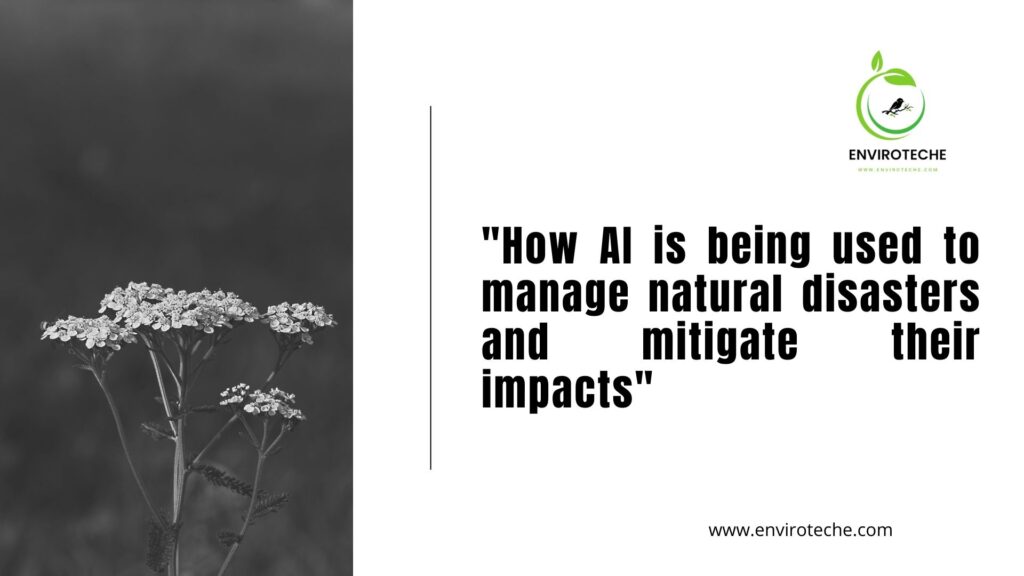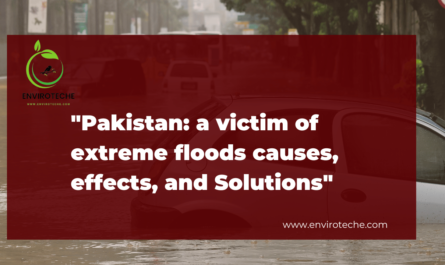
Muhammad Ali Amir1, Shazma Ilyas1
1Department of Environmental Sciences, Government College University Faisalabad
Introduction
Extreme weather events and climate change have risen over the past few decades, with detrimental repercussions on society that include greater insecurity, the devastation of ecosystems, rising levels of poverty, fatalities among humans, and global economic losses. Modern methods including continuous and remote earth monitoring, data gathering, model building for big data extrapolation, estimating, in-time warning for mitigation, and more are used to minimize the severity of natural disasters and effectively counteract their negative consequences.
Big data is handled by artificial intelligence (AI), which is also used for calculations, forecasts, and predictions of impending natural disasters. AI is also used to prepare people for negative changes by presenting them with a variety of options and guiding them toward making the best choice.
In this blog, we go into great detail about how artificial intelligence is used to handle natural disasters and lessen their effects.
Artificial Intelligence for Early Warning and Disaster Prediction
Due to improvements in object recognition, picture identification, natural language processing, and robotic process automation, artificial intelligence has become a feasible technique for disaster risk management. Numerous research has suggested using AI approaches to enhance monitoring and prediction, giving emergency authorities more time to prepare early warning systems.
Neural networks and other machine learning techniques are frequently used in research in this area to forecast and predict emergencies. (Abhigna et al., 2017), monitoring natural disasters with swarm robotics-based solutions (Chowdhury et al., 2017), predicting the failure of dams using artificial neural networks (ANN) (Danso-Amoako et al., 2012), observing volcanic ash with robotic tools (Nagatani et al., 2013), and predicting water levels using methods like NNARX and ANN with particle swarm optimization (Ruslan et al., 2013).
Predictive Analysis
Seismic data can be used by artificial intelligence to study earthquake patterns and magnitude. It may be possible to anticipate earthquakes with such data. For instance, google and harvard are creating an AI system that can forecast earthquake aftershocks.
Resource Allocation
Artificial intelligence has the ability to lessen the harm by more effectively and efficiently allocating resources for assistance. It can quicken the distribution of aid and help front-line relief workers make more informed decisions. It is possible to geotag damaged structures and pathways to assist relief workers in locating susceptible regions and allocating resources efficiently for a quicker response and rehabilitation. AI can calculate the best path based on damage assessment maps to give relief more quickly in disaster zones.
Rescue and Recovery
A rescue robot is one that is designed to help with human rescue and search operations. In besides assisting with rescue operations, they might additionally assist with searching, mapping, cleaning debris, distributing supplies, providing medical care, or evacuating people.
Communication
Algorithms based on artificial intelligence can be used to swiftly locate and analyse data to pinpoint locations in need of support and to give folks in the impacted area real-time updates. This can make sure that individuals are aware of the circumstances and have access to the resources they require.
Case Studies
Nine climate calamity incidents had losses in excess of $1 billion as of July 2022, according to the National Centers for Environmental Information. The estimated $47 billion in claimed damages from Hurricane Ian, the storm which has claimed more than 100 lives, might make it the costliest hurricane in Florida history. 3.4 million children in Pakistan are at a greater risk of waterborne infections, drowning, and starvation as a result of the floods that have killed 1678 people since June 2022 and destroyed villages and infrastructure. In Puerto Rico, Hurricane Fiona cut off the electricity to 900,00 people.
The use of advanced technologies like artificial intelligence (AI) provides the ability to stop or lessen the damage caused by natural catastrophes, which are becoming increasingly common and destructive around the world. With the help of AI, we can now forecast natural disasters and take action to lessen or even avoid them.
Challenges and Limitations
Using artificial intelligence will improve our capacity to handle disasters. To reap its benefits, though, one must recognize and resolve its drawbacks. When collecting data for AI-based algorithms, a number of constraints and/or technological concerns must be taken into account. Some of these have to do with the amount of data, like: Are the data adequate and representative? How are they kept and distributed?
There are also issues with data quality, like whether the data need calibration or adjustment. Has the desired spatiotemporal precision been achieved? Are impartial data accessible to test the algorithm? The accessibility of data can be an obstacle when employing AI to identify extreme events like avalanches or earthquakes. If a training dataset includes a huge number of events, AI-based techniques may be quite effective. However, because of the rarity of these incidents, there is a limited amount of data available.
Conclusion
AI has huge potential for managing catastrophic events and lessening their effects. AI-based solutions can offer in-the-moment data and analysis to facilitate better decision-making in crisis situations. They can aid in setting priorities for response actions, determining which areas most urgently require assistance, and even helping to find and save people in devastated regions. However, there are obstacles and restrictions to employing AI in controlling natural disasters, like the need for sophisticated infrastructure and a lack of data availability.
Overall, the increasing use of AI in managing natural disasters offers significant opportunities to improve disaster response and mitigate their impacts on human life and infrastructure. By continuing to invest in AI-based systems, we can better prepare for and respond to natural disasters, ultimately saving lives and reducing damage. Overall, the growing application of AI to the management of natural disasters presents great prospects to enhance disaster response and lessen the effects of disasters on infrastructure and human life. We can better plan for and deal with natural disasters by continuing to make investments in AI-based solutions, eventually preserving lives and minimizing damage.
References:
Snezhana, D. (2023). Applying Artificial Intelligence (AI) for Mitigation Climate Change Consequences of the Natural Disasters. Dineva, S.(2023). Applying Artificial Intelligence (AI) for Mitigation Climate Change Consequences of the Natural Disasters. Research Journal of Ecology and Environmental Sciences, 3(1), 1-8.
Abhigna, P., Jerritta, S., Srinivasan, R., & Rajendran, V. (2017, April). Analysis of feed forward and recurrent neural networks in predicting the significant wave height at the moored buoys in Bay of Bengal. In 2017 International Conference on Communication and Signal Processing (ICCSP) (pp. 1856-1860). IEEE.
Chowdhury, F. H., Nahian, R., Uddin, T., Rezwan, S., Khan, M., Sufian, A., … & Hassan, N. N. (2017, July). Design, control & performance analysis of forecast junction IoT and swarm robotics based system for natural disaster monitoring. In 2017 8th International Conference on Computing, Communication and Networking Technologies (ICCCNT) (pp. 1-5). IEEE.
Danso-Amoako, E., Scholz, M., Kalimeris, N., Yang, Q., & Shao, J. (2012). Predicting dam failure risk for sustainable flood retention basins: A generic case study for the wider Greater Manchester area. Computers, Environment and Urban Systems, 36(5), 423-433.
Nagatani, K., Akiyama, K., Yamauchi, G., Otsuka, H., Nakamura, T., Kiribayashi, S., … & Mackay, R. (2013, October). Volcanic ash observation in active volcano areas using teleoperated mobile robots-Introduction to our robotic-volcano-observation project and field experiments. In 2013 IEEE International Symposium on Safety, Security, and Rescue Robotics (SSRR) (pp. 1-6). IEEE.
Ruslan, F. A., Zakaria, N. K., & Adnan, R. (2013, August). Flood modelling using artificial neural network. In 2013 IEEE 4th Control and System Graduate Research Colloquium (pp. 116-120). IEEE.
Gevaert, C. M., Carman, M., Rosman, B., Georgiadou, Y., & Soden, R. (2021). Fairness and accountability of AI in disaster risk management: Opportunities and challenges. Patterns, 2(11), 100363.A natural disasters
Check Other Schlorships:


Interesting topic